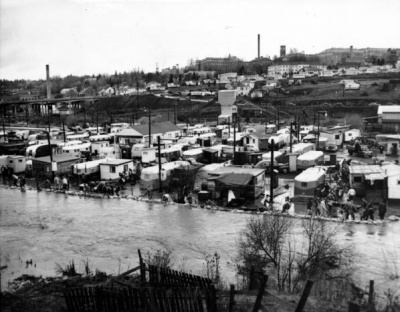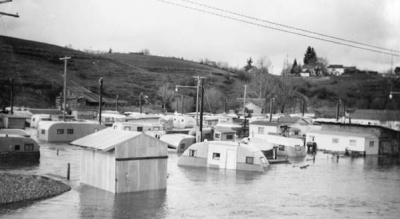Personal tools
Help
Tools
Class Notes
- Do you have news for fellow WSU alumni and other readers of Washington State Magazine? Send us your class note.
Our Story
written by alumni, faculty and friends.
NOTE: THIS IS A LEGACY SITE AND IS NOT REGULARLY MAINTAINED
Views
Difference between revisions of "Floods Of 1948"
From Our Story
MarkOEnglish (talk | contribs) |
MarkOEnglish (talk | contribs) m (fixing typo) |
||
| (One intermediate revision by the same user not shown) | |||
| Line 1: | Line 1: | ||
| − | |||
| − | |||
<br> | <br> | ||
| Line 15: | Line 13: | ||
<br> | <br> | ||
| − | [[Image:Flood1948 1.jpeg|thumb|400px|right|Trailer Camp after flood, February 26th, 1948. Click to view larger version. Image courtesy of WSU Libraries: Manuscripts, Archives, and Special Collections]]As he had in the previous floods, WSC President Wilson Compton opened the Stadium Commons cafeteria as a refuge for the trailer residents; in the aftermath of the flood the President's House was used as a clearinghouse for housing refugees. Again the town and school came to the support of those in need, and the following week Dr. Compton, in an expression of gratitude, noted that all the dislocated families were found places to stay within the community within twelve hours (three times the total number of needed homes had been offered by Pullman residents). The college made a variety of allowances to ensure the refugees' schooling was | + | [[Image:Flood1948 1.jpeg|thumb|400px|right|Trailer Camp after flood, February 26th, 1948. Click to view larger version. Image courtesy of WSU Libraries: Manuscripts, Archives, and Special Collections]]As he had in the previous floods, WSC President Wilson Compton opened the Stadium Commons cafeteria as a refuge for the trailer residents; in the aftermath of the flood the President's House was used as a clearinghouse for housing refugees. Again the town and school came to the support of those in need, and the following week Dr. Compton, in an expression of gratitude, noted that all the dislocated families were found places to stay within the community within twelve hours (three times the total number of needed homes had been offered by Pullman residents). The college made a variety of allowances to ensure the refugees' schooling was not impacted, and the Red Cross provided those in need with new textbooks and clothing. |
<br> | <br> | ||
WSU's Manuscripts, Archives, and Special Collections' digital collections contain [http://content.wsulibs.wsu.edu/cgi-bin/queryresults.exe?CISOROOT8=%2Fpullman&CISOROOT13=%2Fhutchison&CISOOP=adv&CISOFIELD1=CISOSEARCHALL&CISORESTMP=%2Fsite-templates%2Fsearch_results.html&CISOVIEWTMP=%2Fsite-templates%2Fitem_viewer.html&CISOMODE=grid&CISOGRID=thumbnail%2CA%2C1%3Btitle%2CA%2C1%3Bsubjec%2CA%2C0%3Bdescri%2C200%2C0%3B0%2CA%2C0%3B10&CISOBIB=title%2CA%2C1%2CN%3Bsubjec%2CA%2C0%2CN%3Bdescri%2CK%2C0%2CN%3B0%2CA%2C0%2CN%3B0%2CA%2C0%2CN%3B10&CISOTHUMB=2%2C5&CISOTITLE=10&CISOBOX1=floods+and+1948+and+Pullman&x=15&y=9 many more photographs from the 1948 floods]. | WSU's Manuscripts, Archives, and Special Collections' digital collections contain [http://content.wsulibs.wsu.edu/cgi-bin/queryresults.exe?CISOROOT8=%2Fpullman&CISOROOT13=%2Fhutchison&CISOOP=adv&CISOFIELD1=CISOSEARCHALL&CISORESTMP=%2Fsite-templates%2Fsearch_results.html&CISOVIEWTMP=%2Fsite-templates%2Fitem_viewer.html&CISOMODE=grid&CISOGRID=thumbnail%2CA%2C1%3Btitle%2CA%2C1%3Bsubjec%2CA%2C0%3Bdescri%2C200%2C0%3B0%2CA%2C0%3B10&CISOBIB=title%2CA%2C1%2CN%3Bsubjec%2CA%2C0%2CN%3Bdescri%2CK%2C0%2CN%3B0%2CA%2C0%2CN%3B0%2CA%2C0%2CN%3B10&CISOTHUMB=2%2C5&CISOTITLE=10&CISOBOX1=floods+and+1948+and+Pullman&x=15&y=9 many more photographs from the 1948 floods]. | ||
| + | |||
| + | <br> | ||
| + | |||
| + | ''Contributed by University Archivist Mark O'English, February, 2009.'' | ||
<br> | <br> | ||
Please be sure to click on the '''Discussion''' link at the top of the page to share your stories or photos about this! You'll need to '''Log In''' (at the upper left) and create an account to do so. | Please be sure to click on the '''Discussion''' link at the top of the page to share your stories or photos about this! You'll need to '''Log In''' (at the upper left) and create an account to do so. | ||
Latest revision as of 20:34, March 31, 2009
Unfortunately, that day's record as "worst ever flood" was short lived, and a month and a half later, on February 21st, the Creek's waters rose up and threatened the camp again, this time a full foot deeper than January's flood. Extensive work by the university students and the Pullman townspeople resulted in an even larger dike, and once again the trailer court's residents escaped the worst of the flooding.
Four days later, on February 25th, 1948, the river rose again in a flood deeper than either of the two of the previous months, and again the students and townspeople met it with sandbags. About 5:00 AM on the morning of the 26th, however, the dikes broke at the upper dam in two places, and the trapped waters rushed downstream, instantly inundating the camp and trapping its occupants, may of whom were home and sleeping. The following day's "Evergreen" recounts that "a human chain was formed across a narrow crossing (waist deep) and the victims passed along and out to safety." Many of the residents were incapable of fighting the current, and had to be carried out on the shoulders of volunteers. On her notations on photos donated to the University Archives, Marjorie (Schmid) Kee recalls having been asleep in her and her husband's trailer when the dikes broke, and having to swim to the railroad embankment where volunteers were able to pull her from the waters. In the "Evergreen," student Joe Sobello reports that he'd just evacuated himself, his wife, and their two year old son when the dike broke, and he witnessed his home wash away, hit another trailer, and break into pieces. Loyd Bury, owner of the trailer camp area, reflected "it is a miracle no lives were lost. If it had not been that we had a group of war trained veterans, there must surely have been a loss of life."
WSU's Manuscripts, Archives, and Special Collections' digital collections contain many more photographs from the 1948 floods.
Contributed by University Archivist Mark O'English, February, 2009.
Please be sure to click on the Discussion link at the top of the page to share your stories or photos about this! You'll need to Log In (at the upper left) and create an account to do so.
Our Story site map
Our Story main page | Our Story categories | Help Desk
Contact | Give | Advertise
Washington State Magazine | Washington State University | Class Notes
Our Story is coordinated by
In partnership with
Our Story and Washington State Magazine are publications of Washington State University. All rights reserved.
P.O. Box 641227, Washington State University, Pullman, WA 99164-1227 USA | wsm@wsu.edu, 509-335-2388
Accessibility | Copyright | Policies


